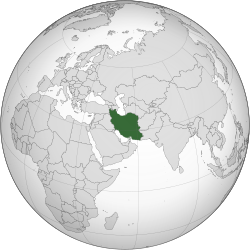
Back الحكومة الإيرانية المؤقتة Arabic ایران مووقت حؤکومتی AZB ইরানের অন্তর্বর্তীকালীন সরকার Bengali/Bangla Gobierno interino de Irán Spanish دولت موقت ایران Persian Iranin väliaikaishallinto Finnish Gouvernement provisoire de l'Iran French Governo provvisorio dell'Iran Italian イラン暫定政府 Japanese 이란 임시정부 Korean
| History of Iran |
|---|
 The Gate of All Nations in Fars |
|
Timeline |
The Interim Government of Iran (Persian: دولت موقت ايران, romanized: Dowlat-e Movaqat-e Irân) was the first government established in Iran after the Iranian Revolution. The regime was headed by Mehdi Bazargan, one of the members of the Freedom Movement of Iran,[3] and formed on the order of Ayatollah Khomeini on 4 February 1979. From 4 to 11 February, Bazargan and Shapour Bakhtiar, the Shah's last Prime Minister, both claimed to be the legitimate prime minister; Bakhtiar fled on 11 February.[4] Mehdi Bazargan was the prime minister of the Interim government and introduced a seven-member cabinet on 14 February 1979. Ebrahim Yazdi was elected as the Foreign Minister.[5]
The constitution of the Islamic Republic of Iran was adopted by referendum on 24 October 1979. Before it could come into force on 3 December 1979, however, the government resigned on 6 November soon after the taking over of the American embassy.[6] The Council of the Islamic Revolution then formed the Interim Government of Iran (1979–80) until the formation of the first Islamic Consultative Assembly on 12 August 1980. Mehdi Bazargan was elected to the first Islamic Consultative Assembly representing Tehran.[7]
- ^ The Flag Bulletin, vol. XX, The Flag Research Center, May–June 1981, ISSN 0015-3370,
The development of new symbols in Iran was a slow process. Monuments and other visible expressions of imperial power, especially those associated personally with the deposed shah, were quickly eliminated; the imperial crown immediately disappeared from the war flag and ensign. Nevertheless other flags continued in use – the civil flag and ensign (plain green-white-red stripes) and the state flag and ensign (the same stripes with the lion and sun in the center). The lion and sun also continued as the state arms
- ^ Sanam Zahir (2008), The Music of the Children of Revolution: The State of Music and Emergence of the Underground Music in the Islamic Republic of Iran with an Analysis of Its Lyrical Content, ISBN 9780549893073,
A contrast to these two anthems is the song that was used during the revolution of 1979 as the de facto national anthem of the transition period. This song, Ey Iran is argued here...
- ^ Reza Safa (2006). The Coming Fall of Islam in Iran: Thousands of Muslims Find Christ in the Midst of Persecution. Charisma Media. p. 78. ISBN 9781591859888.
- ^ Mir M.Hosseini. "February, 5, 1979 A.D.: Bazargan Becomes Prime Minister". The Iranian history article. Archived from the original on 25 December 2018. Retrieved 17 July 2016.
- ^ Samih K. Farsoun, Mehrdad Mashayekhi (22 November 2005). Iran: Political Culture in the Islamic Republic. Routledge. p. 173. ISBN 9781134969470.
- ^ Nikou, Semira N. "Timeline of Iran's Political Events". United States Institution of Peace. Retrieved 10 August 2013.
- ^ Mehdi Noorbaksh. "Mehdi Bazargan's Biography". Cultural Foundation of Mehdi Bazargan. Retrieved 16 July 2016.



